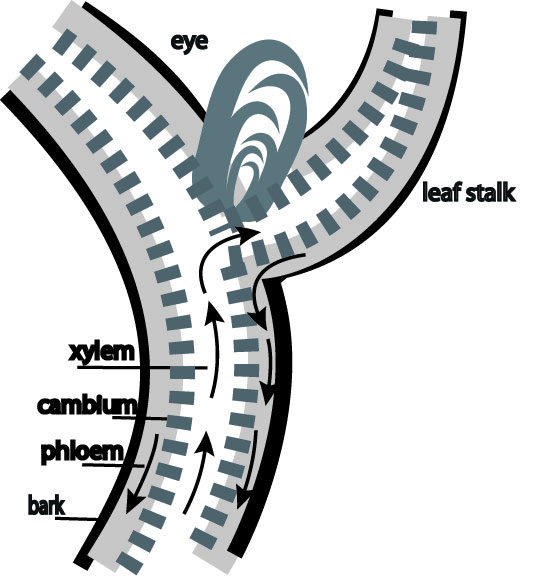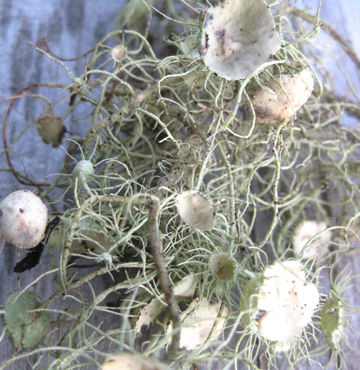The Alchemy of Plant Hormones & Plant Spray Applications
By Dennis Klocek 7 min read
Editors note: in this article Dennis refers to the alchemical principles of Sal (Salt), Sulf (Sulphur) and Merc (Mercury). See Video 5 here for more on Sal, Sulf and Merc.
In the quartet of phosphorus, potassium, sulfur and magnesium, the Sal and Sulf influences on the life processes of plants can be identified. The phosphorus and potassium issue in ‘NPK thinking’ revolves around the highly attractive nature of phosphorus for other minerals and the strong tendency for potassium to constantly form deposits through combination.
Phosphorus with its deep link to oxygen is highly attractive for metallic elements in a soil solution. Potassium (a metal) quickly fills this attraction and links with carbon to form tissues. This is a Sal process, the formation of an ash out of a solution. Sal represents the forces of attraction towards deposition.

Within the habit of mind that is current thinking, magnesium is not thought to be as critical as NPK (nitrogen, phosphorus and potassium). This may be because P (phosphorus) and K (potassium) are minerals that form an ash that can be analyzed. It is difficult to get an ash to analyze from a burning piece of magnesium.
Both magnesium and phosphorus are highly reactive and burst into light and flame when given access to air. It takes complex technology to get pure phosphorus and pure magnesium. They exist in nature mostly in reactive combination with other substances. However, by bursting into flame and light in their pure form they reveal a common and fundamental relationship to light.
From the perspective of the light energies and mineral formations it can be said that phosphorus in nature instigates a descending path for light and the energies of life. Phosphorus quickly loses life movement to become fixed (Sal) into matter. On the opposite or Sulf side we could say that magnesium instigates a path for light to once again unfix from matter and enter into life.
The diagram places phosphorus and magnesium at two outer poles regarding light. Phosphorus attracts light and fixes it into substance; magnesium receives light and distributes it throughout the growing plant where it provides the vehicle for continued growth processes threatened by the fixing activity of phosphorus. This is an alpha/omega relationship to light in these two minerals.
In the central part of the diagram, potassium on the Sal side is polar to sulfur on the Sulf side. Potassium in nature is a salt or ash that falls out of the life cycle in order to become visible matter. Its character is deposition.
On the Sulf side, sulfur is a mineral that can self-sustain burning if given oxygen. If the mineral residue is analyzed after burning it will reveal a complete absence of sulfur. The active force of the dissolving power of sulfur has escaped from being intimate with matter to fly away to combine with water vapor.
The two salts potassium and calcium are often related to each other in the plant sap. Calcium and potassium are fixing agents on the sal side that need sulfur to become active in living things. Sulfur is a necessary activator for both. These inner relationships point to the inner dynamics of minerals in plant sap that serve as the foundational influences for hormone regulation of plant growth.
The formative or Sal hormone is auxin and the dissolving or Sulf hormone is cytokinin. The extraction of these minerals and hormones can be accomplished by small scale fermenting practices that produce spray solutions that are rich in these substances in a very dynamic form.
These dissolving, precipitating, changing actions are well within the scope of a grower who wishes to become more intimate with the hidden conversations that take place between minerals and plants. Superior vegetables, fruits and medicinal herbs are the result.
The Sal process characterised by light moving into substance is the action of the PGR (plant growth regulator) auxin. The Sulf process where light is making its way back into life is the realm of action of the PGR cytokinin. Processes requiring a governing action are regulated by the PGR gibberellin.
Gibberellin is always present where the other two are in interaction. Even the metabolism of the yeasts and bacteria involved in fermenting introduce adequate amounts of gibberellin to balance the other two in the creation of the base ferment. Herbal supplements when extracted with the base can tailor the spray program to the specific needs of the grower.
All of these actions are well within the scope of a grower who wishes to become more intimate with the hidden conversations that take place between minerals and plants. Superior vegetables, fruits and medicinal herbs are the result. Rational spray programs can be developed based on the particular hormonal needs in various stages of plant development.

Downward root development of a germinating radicle is guided by cytokinin while the maturing secondary roots activate auxin. Once a root erupts downwards from a seed a xylem flow from the root upwards is established and regulated by cytokinin.
At the cambium where a leaf petiole joins the stalk the vessels of phloem transport flow from leaf to root. This opposite movement is regulated by auxin. In a greenwood shoot lateral bud break is regulated by cytokinin; terminal bud development generates auxin.
In flower formation cytokinin dominates the pre-bud break pistil / calyx development up to the corolla, while auxin stimulates anther and pollen formation and the development of the sperm tube in a fructified pistil. This controls fruit set but then fruit development once again centers on the influence of cytokinin.
These hormone patterns are never found without the polar influence of both being present even in the most minute areas of the cell. However different rhythmically arranged stages require the action of either one or the other to predominate. Anticipating these change rhythms and having on-hand hormonal extracts that can support the particular phase of a plant’s development takes to another level the practice of regulating plant growth through natural hormonal extractions applied as foliar sprays.
The base fermenting process that makes use of grain vinegar, coconut water, and macerated fava seedling roots serves as a good vehicle for extracting these minerals from plants that specialize in sequestering them.
The parsley plant is a specialist in keeping a good flow of available phosphorus. Parsley balances phosphorus so that it maintains its functionality. We could call its ferment extract labile, or available phosphorus. The living parsley plant has rendered the phosphorus capable of continuous activity. A phosphorus adjunct to parsley is the mineral langbeinite known as sul/po/mag, (sulfur/potassium/magnesium).
This natural mineral is an ancient marine deposit of these three minerals in a highly balanced form. The mineral form can be dissolved in boiling water and stored. A small amount added to the parsley extraction gives the P/K relationship a mineral template for ionic flexibility. As a mineral, langbeinite has solved the equation between potassium in the Salt pole and sulfur and magnesium in the Sulf pole. Together, parsley and langbeinite offer a store of these key minerals in a balanced form when applied in a foliar spray.

The addition of other herbs for specific targets is also useful in the base ferment. Usnea hirta, a lichen, and Artemisia annua (sweet Annie) in the daisy family can be added to help the plant balance strong energy shifts in plant sap electrolytes as demands of minerals change from growing cycles to the production of fruit and seed. Usnea and sweet Annie specifically influence the integrity of mitochondria in cells. To prevent ageing due to stress they regulate the permeability of mitochondrial membranes and temper their metabolic rates.
To deal with heat and drought stress, herbs that produce soft leaf waxes can be extracted in the base ferment. Soft waxes regulate the function of the respiratory organs in the leaf known as stoma. In strong temperature swings, the stoma must open and close in quick response to water stress signals. Hard wax covers the surface of leaves but is not functional to regulate stoma found on the under-sides of leaves. The softer waxes enable the stoma on the underside to easily open and close. The tea plant is known for its complex waxes. Camellia flowers are in the same family as tea. The soft, abundant, waxy flowers of camellia when fermented release the soft wax of their petals into solution, making it available to the sprayed leaf.
If accelerated ripening is desired, the base spray with the addition of vitamin C accelerates the breakdown of pectins in the cell walls of ripening fruits. Pectins are complex carbohydrates that form embryonic fruit cell complexes out of cellulose as a just-set fruit is doing its initial swelling. The cellulose needs to be dissolved later at ripening time by vitamin C. The cellulose that is broken down produces the sugars that change the ripening flesh from sour to sweet.
To further enhance ripening a signalling hormone ethylene is used by plants to guide this process. The switch that turns on the dissolving action of the vitamin C processes is ethylene, a gas produced by ripening processes in some fruit. At harvest, saving the skins of peaches, apples, and bananas and fermenting them in the base provides a liquid that when filtered can be stored to provide a later source rich in ethylene for late ripening.
Ethylene is a signalling hormone that quickens other reactions and can be of benefit when ripening processes have stalled. Together ethylene and vitamin C in a spray can restart a stalled ripening process in such crops as citrus fruits that are ripening into the cold or medicinal plants that are maturing into an early fall.

Dennis Klocek
Dennis Klocek, MFA, is co-founder of the Coros Institute, an internationally renowned lecturer, and teacher. He is the author of nine books, including the newly released Colors of the Soul; Esoteric Physiology and also Sacred Agriculture: The Alchemy of Biodynamics. He regularly shares his alchemical, spiritual, and scientific insights at soilsoulandspirit.com.
Similar Writings
Scientific Hypotheses – Truth or Error?
[Republished from Journal of Anthroposophical Medicine (JAM) Vol.10 1993] If one were to approach a professional scientist and challenge the hypothetical method as a flawed premise for good science, one would surely be met with vigorous protest. And, indeed, the protest would be well founded, because the hypothetical method is a well-proven cornerstone of scientific…
Video: Sow seeds once, harvest all season – The process of “pricking out”
By transplanting and separating seedlings based on their vigor, you can benefit from nature’s own strategy of staggering growth among seeds to give you a harvest all season long from one sowing.